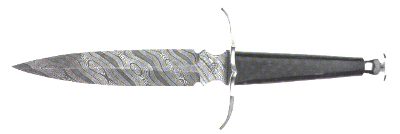
The Pattern Welded Blade
Artistry in Iron
Hardbound, 113 pages, ~90 illustrations
Paladin Press ISBN 0-87364-773-4

|
Dr. Jim Hrisoulas The Pattern Welded Blade Artistry in Iron Hardbound, 113 pages, ~90 illustrations Paladin Press ISBN 0-87364-773-4 |
Technology!Prior to Huntsman's rediscovery of the crucible process, circa 1757, the ability to produce steel of consistant quality was a dream. From ancient times the smelting process redered a random series of bars ranging in carbon content from wrought to cast iron. Steel could be had, but of what hardenability? Each new batch required the smith to test and re-test his material; an expensive proposition.
We love it. The only thing we desire more is;
Improved Technology!!
We always have and always will.
By 1000 AD smiths throughout the ironworking world had developed the technique of combining several grades of metal, repeatedly welding and forging and the billet in order to produce a steel of known character. This was expensive both in time and material, reguiring the re-refined ateel to be reserved for only the most important tools: swords, knives, and axes (these were "interesting times" you know).
This refining method carried with it both a functional and aesthetic reward. When the finished tool was either highly polished or subjected to an etching solution, the multiple layers created a pattern pleasing to the eye. By manipulating this usually straight-lined pattern, the smith could produce a finished piece of magical beauty.

This is not a book for the beginner, although it could provide inspiration to same. The simultaneous welding of multiple layers of metal involves a sound understanding of forge, steel, flux and forging. It is for those that have confidence in their ability to forge weld.
Format is a well organized progression from tools, to materials, to method and technique, to heat treatment and final finishing, concluding with a very useful appendix.
Illustrations, especially in the chapters involviong pattern manipulation, are excellent. By the combination of photographs and line drawings the authors words lose any possible ambiguity. Initialy this reviewer was confused by certain line illustrations as to the angle fro which the billet was being viewed. If the reader should become similarly lost beyond the Iron Woodline, a journey to chapter 5, The Composite Patterns, will quickly restore your bearings.
Text is concise without being terse. The author, although obviously loving what he does, has not written a Romance Novel. He has written an intelligence report. Sentences and paragraphs are consistently structured on a "need to know" basis. The information presented is strictly 1-A.
The reviewer has very few complaints or disagreements with the The Pattern Welded Blade. All disagreements amount simply to one smiths quirks versus anothers; without which none of us could produce work distinctly our own. The single complaint is with two of the over seventy-eight line drawings in this book. Figures 14 an 15 of chapter 4. It strikes me that the method of pattern manipulation, if followed as illustrated, could result in irreparable cold shuts with possible slag inclusions. The experianced smith will make the necessary adjustments at a glance. The hopeful novice may be devastated. This apparent oversight is assumed the printers, not the author's.
One final caution is extended to the readers of The Pattern Welded Blade. As you absorb the knowledge and become inspired by the photographs of truly beautiful work contained in this volume, remember this: Jim Hrisoulas is a professional bladesmith. He utilizes most, all (or more!) of the equipment peculir to the modern knife making industry. In the parlance of The Bottom Line this amounts to Booguners og Bucks. With patience, desire, and a minimum of basic tooling, you can produce pattern welded piece of equivalent beauty. However, what requires days of his time will exact weeks or even months of yours. This reviewer has produced a few pieces under similar conditions, and to the fledgling pattern-welder offers the following encouragement. Consider the the advise of the stratagist Sun Tzu to the would-be General:
"If you know the enemy, and you know yourself, in One Hundred battles you will win"The Pattern Welded Blade will greatly assist you in understanding the enemy; the rest is your responsibility.

BACK TO BOOKSHELF |
Copyright © 2000 by Jock Dempsey, DEMPSEY'S FORGE Webmaster email: webmaster@anvilfire.com
|